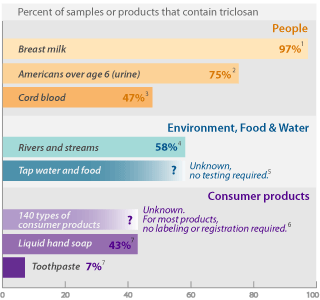THURSDAY, JULY 17, 2008
PESTICIDE IN SOAP, TOOTHPASTE AND BREAST MILK - IS IT KID-SAFE?
Summary & Recommendations
With no assessment of health risks to infants, federal regulators have approved a hormone-disrupting pesticide, triclosan, for use in 140 different types of consumer products including liquid hand soap, toothpaste, undergarments and children's toys. This exposure has been allowed despite the fact that the chemical ends up in mothers' breast milk and poses potential toxicity to fetal and childhood development.

In addition to these risks, Environmental Working Group (EWG) finds no evidence that triclosan's widespread use in liquid hand soap and other products gives consumers the germ-killing benefits they are promised. The American Medical Association, a Food and Drug Administration advisory committee, and dozens of academic researchers have determined that antimicrobial soap does not work any better than plain soap and water at preventing the spread of infections or reducing bacteria on the skin.

As required by law, the Environmental Protection Agency is now reviewing health and safety data for triclosan. This is a critical process that could lead to the stringent health and environmental protections needed to reduce exposure to this toxic antimicrobial agent. However, EPA's draft risk assessment of triclosan gives cause for concern: Plagued with data gaps and inconsistencies, the assessment was crafted to support the status quo.
EPA has approved triclosan for use in 20 pesticide formulations applied to consumer products from credit cards and countertops to baby bibs and blankets. In a callous and unjustified abuse of federal pesticide law, EPA failed to consider the safety of babies' and children's exposure to triclosan in breast milk, mattresses, sleepers, blankets, bibs, toys, house dust, diaper cream, and other potential sources when approving these uses.
Triclosan persists in the environment, breaks down into substances highly toxic to wildlife, pollutes the human body, and poses health risks that are barely studied and poorly understood. Because triclosan has been proven ineffective, and EPA has failed to assess its safety for children, we recommend:
- A ban on triclosan in personal care products and any other products used at home, in line with the conclusion of the American Medical Association that common antimicrobials for which resistance has been demonstrated should "be discontinued in consumer products unless data emerge that conclusively show that such resistance has no effect on public health and that such products are effective at preventing infection."
- For remaining non-consumer uses, EPA must fully assess the safety of triclosan and its breakdown products for the fetus, infant, child, and other vulnerable populations.
- Consumers should avoid the use of triclosan-laden products whenever possible.
- Manufacturers should curtail their use of this toxic, persistent chemical in consumer products, voluntarily in advance of mandatory restrictions.
TRICLOSAN IN CONSUMER PRODUCTS LEADS TO WIDESPREAD
POLLUTION IN PEOPLE AND THE ENVIRONMENT

Notes and references
1 Testing sponsored by triclosan manufacturer Ciba found the pesticide in 60 of 62 breast milk samples from mothers in San Jose, CA and Austin, TX (Dayan 2007).
2 Centers for Disease Control and Prevention (CDC) detected triclosan in 75% of 2,517 people 6 years of age and higher, in tests of the chemical in urine samples (Calafat 2008).
3 Triclosan was detected in 8 of 17 cord blood samples in a study conducted in the Netherlands (TNO 2005).
4 The U.S. Geological Survey (USGS) detected triclosan in 58% of 85 rivers and streams tested in 30 states (Kolpin 2002).
5 Triclosan's toxic breakdown product methyl triclosan has been detected in fish downstream of wastewater treatment plants (Balmer 2004), and studies indicate that it persists in sediment for at least 40 years (Miller 2008). Though its widespread use and persistence in the environment indicate it might pollute tap water and food, testing is not required and no studies on this have been published.
6 EWG researchers compiled a comprehensive listing of 140 types of consumer products that can contain triclosan, from technical information and pesticide labels published by EPA [see the data], and from EWG's in-house database of ingredient listings on 30,000 personal care products (EWG 2008).
7 In a survey of personal care product ingredient labels, EWG found triclosan in 112 of 259 liquid hand soaps (43%) and 47 of 609 toothpastes (7%). The data are drawn from EWG's personal care product ingredient database (EWG 2008).
KEY ISSUES:

No comments:
Post a Comment